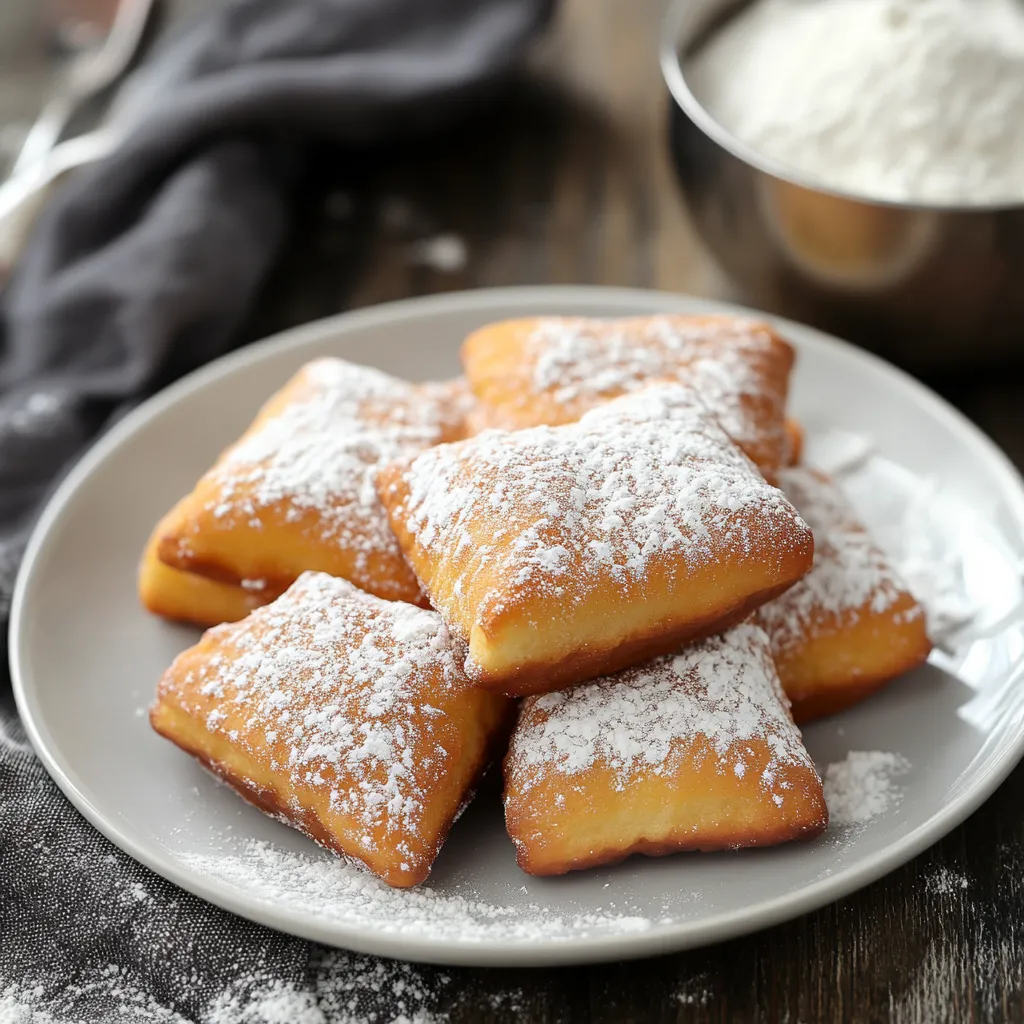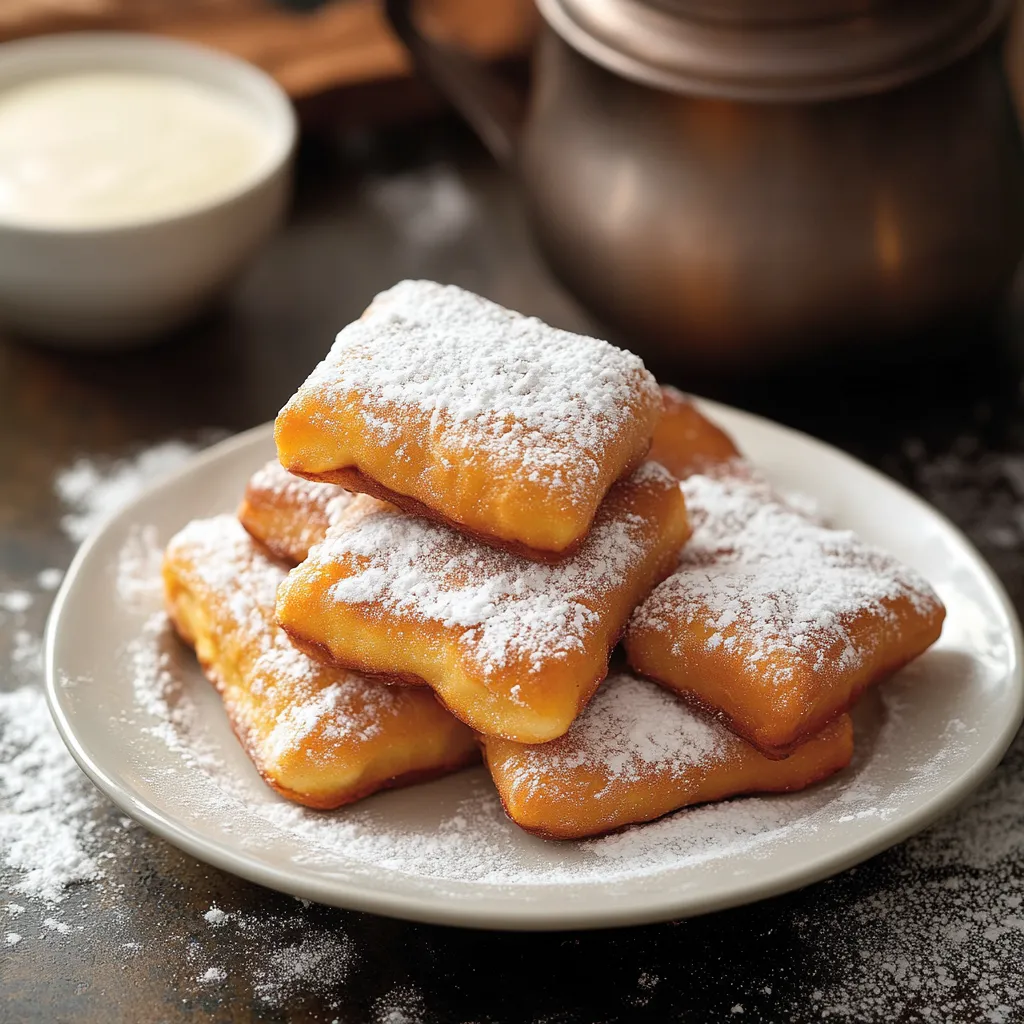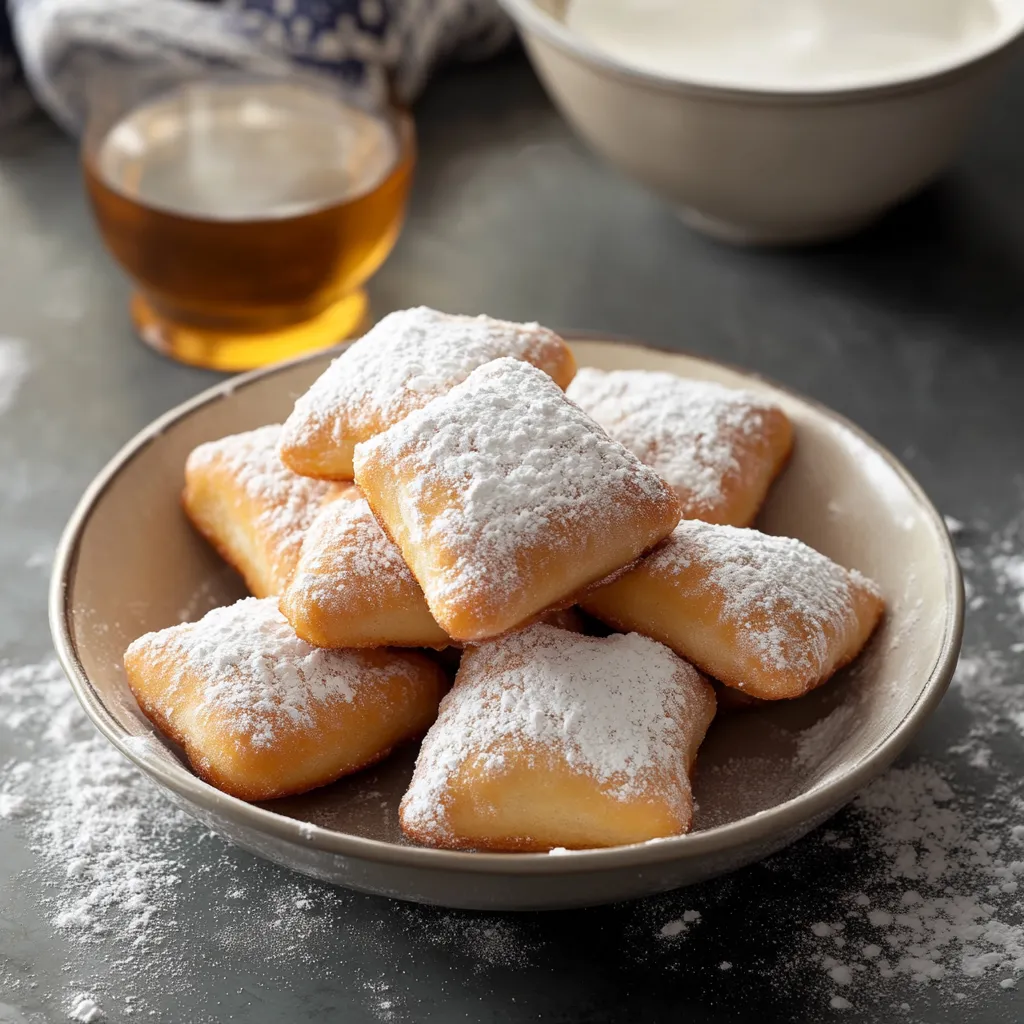 Pin it
Pin it
Pillowy French beignets bring something special to any moment. Their fluffy centers and sweet vanilla scent make everyone hungry. Bite into a golden, soft square dusted with sugar and you’re right in New Orleans—without leaving home. Every piece has that smooth vanilla punch, which is super good for breakfast, dessert, or even just a mid-morning snack. Sure, making these takes a little time, but you’ll get the freshest treat—no store can compare. That crispy outside mixed with the light inside means you’ll keep sneaking back for another one.
My first time making these was a gray afternoon when I just wanted a cozy snack with my coffee. As soon as the dough hit the oil, the house filled with that sugary, warm smell, and everyone rushed to the kitchen. I still laugh about powdered sugar all over my shirt from that first batch. Now, making these is my go-to move when we want to treat ourselves. There’s something calming about working the dough and frying, even on busy weeks. It’s honestly just as much fun to make these as it is to eat them.
Irresistible Ingredients
- Powdered sugar: Dusts each beignet after frying, giving them their famous sweet, snowy top. Go for a brand without tons of cornstarch for pure flavor.
- Vegetable oil: This is what you fry in. Pick one with no strong flavor, like canola or sunflower, so your beignets taste just right.
- Fine sea salt: A pinch pulls all the flavors together and balances the sweet stuff.
- Egg: Room temperature helps it blend right in, adding a little richness and keeping everything together.
- Unsalted butter: Melt and cool it before adding. It makes things rich but lets the vanilla come through.
- Pure vanilla extract: Swirls those real vanilla vibes throughout every bite. Want something different? Try a Madagascar or Tahitian extract and notice the flavor shift.
- Whole milk: Use this for a softer crumb and a bit of richness. It also helps the beignets brown up nice and evenly.
- Granulated sugar: Not just for flavor! It feeds the yeast, helps your dough get golden, and gives a little sweetness.
- Active dry yeast: Makes the dough expand and gets those airy pockets inside. Keep it sealed and use it before it expires.
- All-purpose flour: Your main base here—it’s got enough protein for structure but won’t turn chewy or dense.
Foolproof Beignet Process
- Frying:
- Heat up your oil in a big pot to about 360°F. Gently drop in just a few dough pieces so they have room. Let them puff and brown for 1-2 minutes on each side, then turn them once for perfect color.
- Shape the Dough:
- Once the dough is done rising, roll it to roughly 1/4 inch thick on a floured surface. Slice into 2-inch squares—use a pizza cutter or a sharp knife—and lay them on a baking sheet lined with parchment paper.
- Give It Time to Rise:
- Put your dough in a greased bowl, tuck a damp towel on top, and let it chill somewhere warm for about 1-2 hours. It’s ready when it’s doubled in size.
- Time to Knead:
- Move the dough to a surface dusted with flour and knead for 8-10 minutes till it’s nice and stretchy. When it feels smooth, put it in an oiled bowl and swirl it to coat all sides.
- Mixing the Dough:
- In one bowl, whisk flour, sugar, and salt together. In another, mix warm milk, the cooled butter, your egg, and vanilla. Bring wet and dry together, stirring until sticky dough forms.
- Wake Up the Yeast:
- Pour warm water (110°F) into a small bowl, toss in a spoonful of sugar, and add the yeast packet. Give it a gentle mix and let it stand for 5-10 minutes—it’ll foam and smell yeasty when ready.
 Pin it
Pin it
Tasty Combos
Rich, hot coffee is just what these sweet treats need to balance things out. If you want to go classic, make café au lait—half strong coffee, half steamed milk—and enjoy the real New Orleans vibe.
Mix It Up
Brighten things up by stirring in a little citrus peel when you mix your dough. Lemon, lime, or orange zest changes the game and pairs perfectly with the vanilla.
Keep 'Em Fresh
Once cooled down, stick your beignets in an airtight container lined with paper towels—just leave them at room temperature. Skip the fridge; it’ll just dry them out and ruin the texture.
 Pin it
Pin it
I’ll be honest: my first go at these was a mess, but I kept at it, and eventually, I nailed that light, puffy texture. Giving the dough time to rise and making sure the oil is just right totally changed my results. Now, whenever friends stay over, they hope I’ll make these—and we end up eating, laughing, and getting powdered sugar everywhere. It’s the best kind of happy mess.
Frequently Asked Questions
- → Can I make the beignet dough ahead of time?
- You sure can! Go ahead and mix your Vanilla French Beignet dough up to a day ahead. Just knead, place in an oiled bowl, wrap tightly, and push into the fridge. The cold will slow things down but the yeast still does its thing. When you’re ready for frying, bring it out, let it hang out at room temp for half an hour, then roll, slice, and fry as usual.
- → Why did my beignets deflate instead of puffing up?
- A couple of things can flatten your beignets. Most often it's the oil—if it's below 350°F, the dough just soaks it up and stays flat. Kneading a little too hard can also make the dough too tough to puff. Sometimes it's just the yeast not waking up right or not giving the dough enough time to rise. For best results, check oil temp, go easy on kneading, and let that dough get puffy first.
- → Can I bake these beignets instead of frying them?
- Traditional French Beignets are fried, but you can try baking for a lighter snack. Just heat your oven to 375°F, set dough pieces on a tray lined with baking paper, and bake for about 10-12 minutes 'til golden. Brush with melted butter while they're hot, then shower on powdered sugar. They'll be tasty but don’t expect the same airy, crisp feel as the classic kind.
- → How do I know when the oil is at the right temperature?
- You want your oil around 360°F for the best beignets. A candy or deep fryer thermometer is the easiest way to check. No thermometer? Drop in a dough snippet—it should start sizzling right away and float up. If it barely moves, the oil's too cool. If it browns the dough super fast or smokes, turn the heat down. Aim for a gentle golden bath, not a flash fry.
- → How should I store leftover beignets?
- Fresh and warm is always best, but if you have extra, pop them in an airtight container on your counter for up to two days. To perk them up, pop onto a tray and bake in a 300°F oven for about 5-7 minutes. Give them a new sprinkle of powdered sugar before eating. Skip the fridge—it’ll just dry them out.
